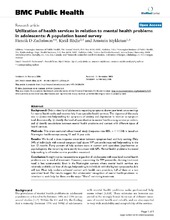Utilization of health services in relation to mental health problems in adolescents: A population based survey
Peer reviewed, Journal article
Published version
Permanent lenke
https://hdl.handle.net/1956/1957Utgivelsesdato
2006-02-16Metadata
Vis full innførselSamlinger
Originalversjon
https://doi.org/10.1186/1471-2458-6-34Sammendrag
Background: Only a minority of adolescents reporting symptoms above case-levels on screenings for mental health seeks and receives help from specialist health services. The objective of this study was to a) examine help-seeking for symptoms of anxiety and depression in relation to symptom load dimensionally, b) identify the level of specialization in mental health among service-providers, and c) identify associations between mental health problems and contact with different types of health services. Methods: This cross-sectional school-based study (response-rate 88%, n = 11154) is based on Norwegian health surveys among 15 and 16 year olds. Results: We found a dose-response association between symptom-load and help seeking. Only 34% of individuals with mental symptom-load above 99th percentile reported help-seeking in the last 12 months. Forty percent of help seekers were in contact with specialists (psychiatrists or psychologists), the remaining were mainly in contact with GPs. Mental health problems increased help seeking to all twelve service providers examined. Conclusion: It might not be reasonable to argue that all adolescents with case-level mental health problems are in need of treatment. However, concerning the 99th percentile, claiming treatment need is less controversial. Even in the Norwegian context where mental health services are relatively available and free of charge, help-seeking in individuals with the highest symptom-loads is still low. Most help seekers achieved contact with health care providers, half of them at a non specialized level. Our results suggest that adolescents' recognition of mental health problems or intention to seek help for these are the major "filters" restricting treatment.
